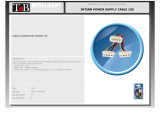Microchip Technology EVK-UTC2000 is an evaluation kit intended for use with USB Type-C devices. It features EVB-UTC2000-DFP designed for use with the Device Firmware Upgrade (DFU) application, and the EVB-UTC2000-UFP for general Type-C testing with a USB host. The kit contains all the necessary hardware and software to help users evaluate the capabilities of USB Type-C devices and implement them into their own designs.
Microchip Technology EVK-UTC2000 is an evaluation kit intended for use with USB Type-C devices. It features EVB-UTC2000-DFP designed for use with the Device Firmware Upgrade (DFU) application, and the EVB-UTC2000-UFP for general Type-C testing with a USB host. The kit contains all the necessary hardware and software to help users evaluate the capabilities of USB Type-C devices and implement them into their own designs.




















-
 1
1
-
 2
2
-
 3
3
-
 4
4
-
 5
5
-
 6
6
-
 7
7
-
 8
8
-
 9
9
-
 10
10
-
 11
11
-
 12
12
-
 13
13
-
 14
14
-
 15
15
-
 16
16
-
 17
17
-
 18
18
-
 19
19
-
 20
20
-
 21
21
-
 22
22
-
 23
23
-
 24
24
-
 25
25
-
 26
26
-
 27
27
-
 28
28
-
 29
29
-
 30
30
-
 31
31
-
 32
32
-
 33
33
-
 34
34
-
 35
35
Microchip Technology EVK-UTC2000 User manual
- Type
- User manual
- This manual is also suitable for
Microchip Technology EVK-UTC2000 is an evaluation kit intended for use with USB Type-C devices. It features EVB-UTC2000-DFP designed for use with the Device Firmware Upgrade (DFU) application, and the EVB-UTC2000-UFP for general Type-C testing with a USB host. The kit contains all the necessary hardware and software to help users evaluate the capabilities of USB Type-C devices and implement them into their own designs.
Ask a question and I''ll find the answer in the document
Finding information in a document is now easier with AI
Related papers
-
Microchip Technology EVB-USB4x12 User manual
-
Microchip Technology EVB-USB5744 User manual
-
Microchip Technology EVB-USB7056 User manual
-
Microchip Technology EVB-UPD301A SRC User manual
-
Microchip Technology MIC38300 User manual
-
Microchip Technology MIC4802 User manual
-
Microchip Technology MCP1642D User manual
-
Microchip Technology MCP1632 User manual
-
Microchip Technology EVB-USB4715 User manual
-
Microchip Technology PAC1921 User manual
Other documents
-
Panasonic FY350ZDY8R Operating instructions
-
MICROCHIP EVB-LAN7430 Operating instructions
-
MICROCHIP ADM00808 Operating instructions
-
MICROCHIP EVB-LAN7800LC-1 Operating instructions
-
MICROCHIP EVB-USB5816 Operating instructions
-
GW Instek How to drive the external device with handler interface Owner's manual
-
EiRA ER2021CU4 User manual
-
 T'nB CAI1 Datasheet
T'nB CAI1 Datasheet
-
MICROCHIP EVB-USB7002 Operating instructions
-
MICROCHIP MIC4605 Evaluation Board User guide



































